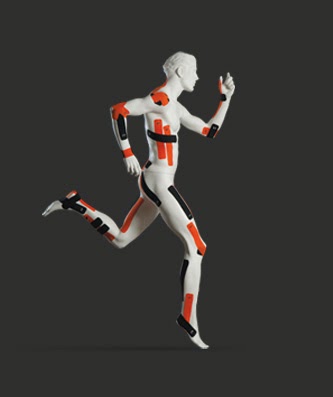 |
| Li Na with kinesio tape on her knee, playing on clay. |
When Chinese tennis star Li Na won the Australian open final this
weekend, she had two long, wide strips of black tape criss-crossing her right
knee. And in the semifinals, Poland’s Agnieszka Radwanska had two similar
pieces of tape criss-crossed over her right shoulder. Sports fans have been seeing this sight for a
few years now: we saw these big pieces of tape slathered across the legs of
many Olympic swimmers in the 2008 and 2012 Olympics.
So what is this tape on the knees, shoulders, and thighs of top
athletes? And more important, does it work?
Why is it so popular? After all, with so many world-class athletes
using it, it must help somehow, right? Nope. Athetic tape has become hugely popular thanks to clever marketing: during the 2008 Olympic games
in Beijing, tape manufacturer KT tape donated its “kinesio tape” to 58 countries for their athletes to use. Many
athletes gave it a try, and millions of viewers saw it on television.
Athletes are notoriously superstitious. If they have a good
performance, they will obsessively try to repeat everything they wore, ate, or
otherwise did that might have led to that performance. Obviously, with so many
athletes wearing elastic tape in 2008 games, some of them performed well. This
merely reinforces the superstition that somehow the tape helped.
 |
| Tape man! (From the KT website.) |
Fortunately, this claim is pretty easy to study, and multiple
studies were done after the 2008 Olympics, looking at the possible benefits of
athletic tape. A review of ten scientific studies published in the journal Sports
Medicine in 2012 found little benefit. They reported that
“The efficacy of KT [kinesio tape] in pain relief was trivial given there were no clinically important results.”
Other studies looked at other effects, and for these the authors reported “KT had some
substantial effects on muscle activity, but it was unclear whether these
changes were beneficial or harmful.” Not a slam dunk for the benefits of kinesio tape, apparently.
Tennis player Li Na was wearing the tape on her knee. What does the
science say about tape for knee pain in particular? Here the evidence is not so clear. A small study last year by Marc Campolo and colleagues compared
at Kinesio Tape® to another taping method called the McConnell Taping (MT)
and to no tape at all. The difference between the tapes is that KT is elastic,
while the MT technique uses rigid tape. This study found a small benefit for
both types of tape on pain while climbing stairs or doing knee squats. This
result is interesting, but the study only had 20 subjects, far too few to say
anything conclusive. And it wasn't "blinded" - the subjects obviously knew they had tape on their knees. So they might have been telling the scientists what they wanted to hear, a common phenomenon in these types of studies.
Of course, the company that sells KT tape is not nearly so careful
in their claims. Their website says:
“KT TAPE is lightweight, comfortable to wear, and can be used for hundreds of common injuries such as lower back pain, knee pain, shin splints, carpal tunnel syndrome, and tennis elbow, just to name a few.”
This is, to put it mildly, a bit of overstatement. As the recent review article stated, when it
comes to pain relief, the evidence shows “no clinically important results.”
There are a remarkable number of studies looking at various kinds of taping for joint or muscle problems, but the evidence is, on the whole, weak at best. My reading is that elastic tape probably has no
more than a placebo benefit. But in sports, a placebo benefit can be
significant: if you think it helps, it might really help.
And think of the other benefits: KT tape
comes in lots of cool colors, and for just a few bucks, you’ll look like a pro. A women's pro, that is: I didn't see any tape on Rafael Nadal or Stanislas Wawrinka in the men's final. Maybe that's because removing a big piece of tape from a hairy leg has got to hurt.
